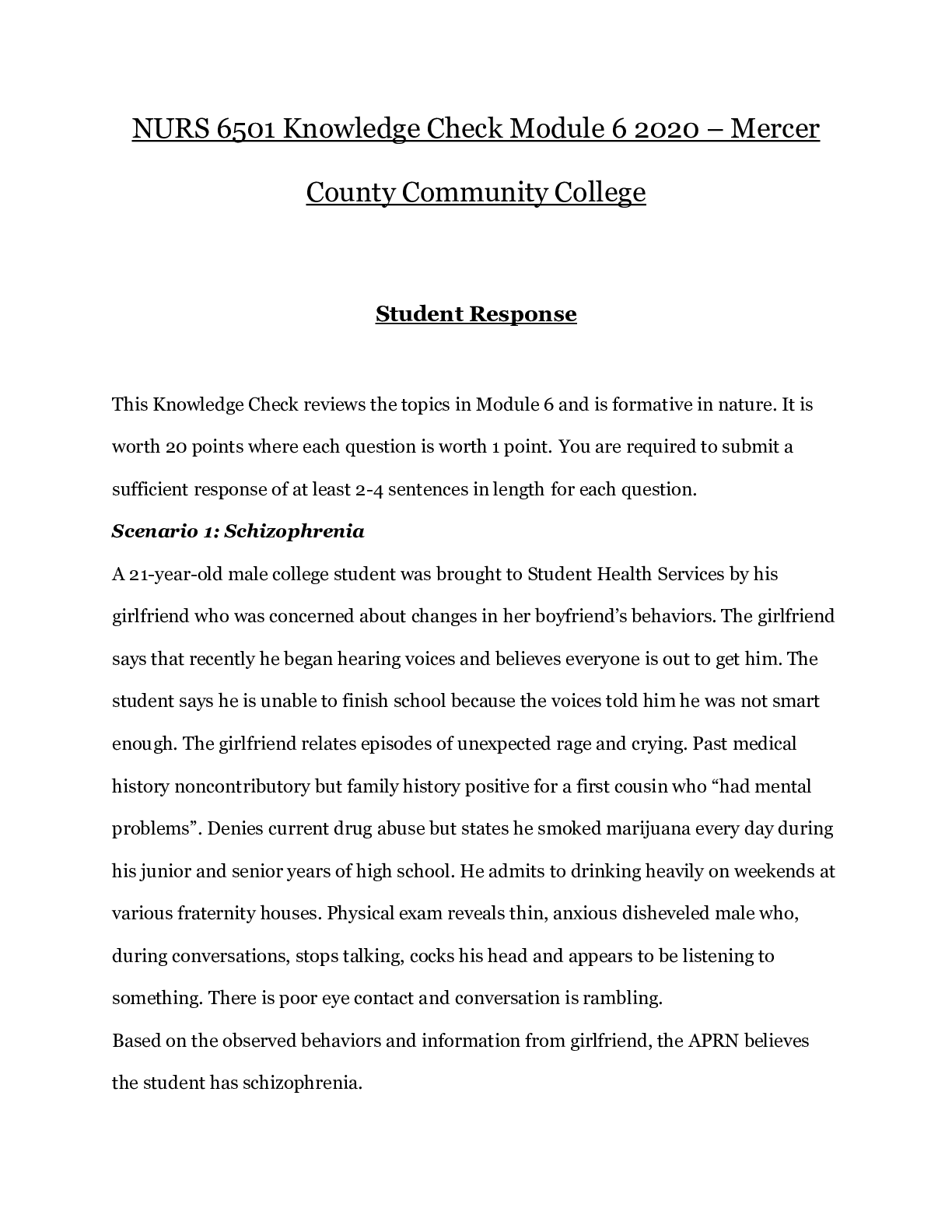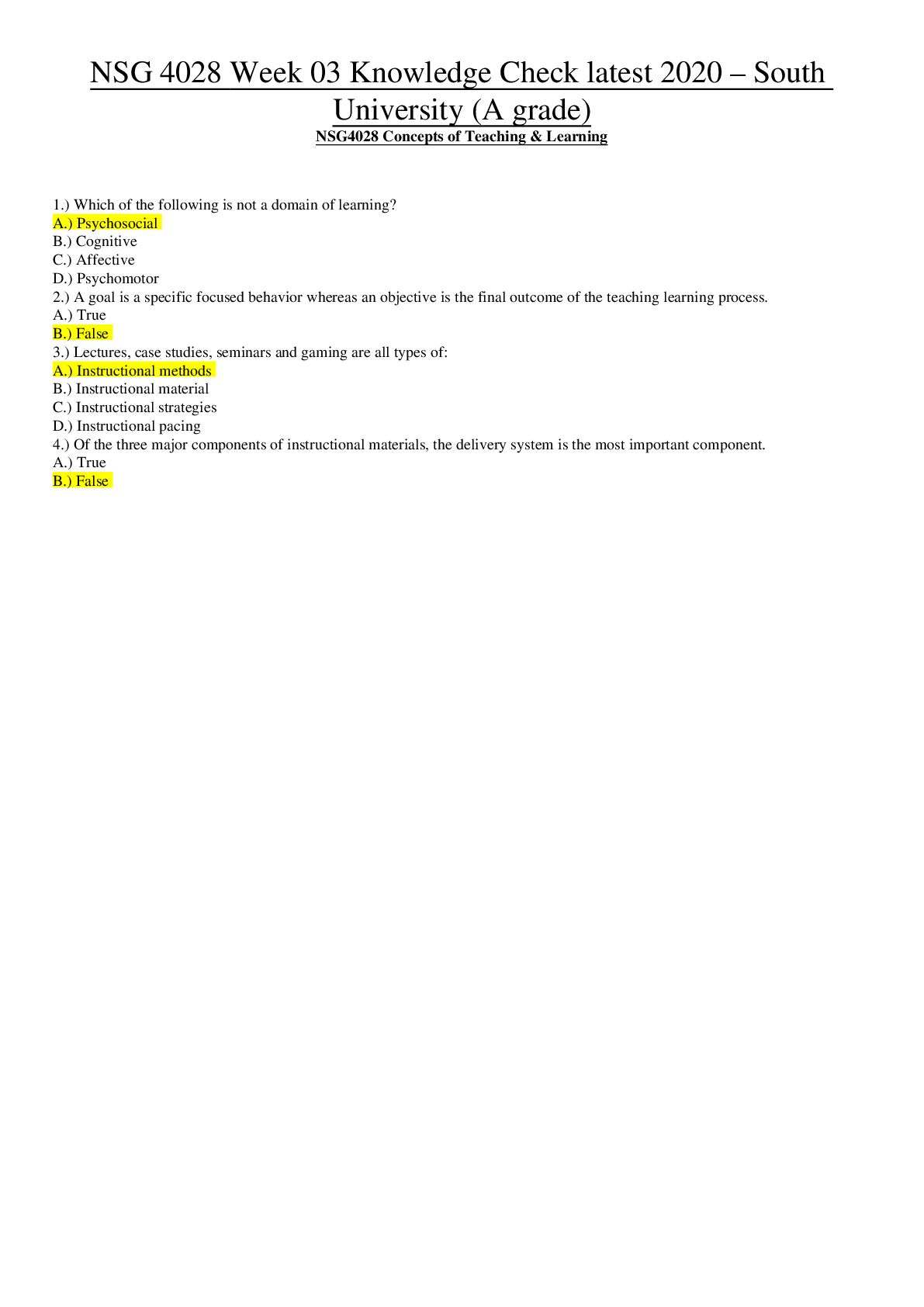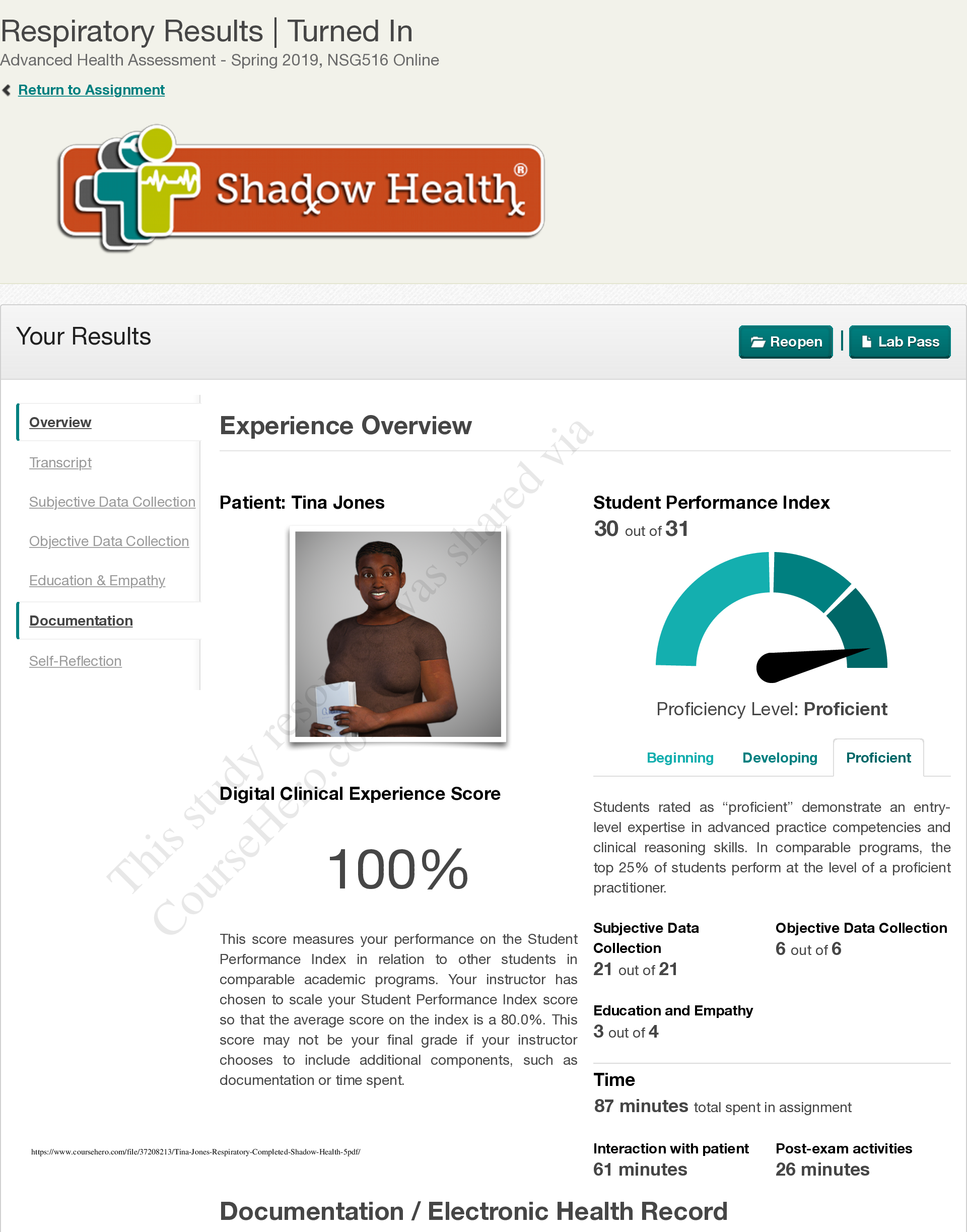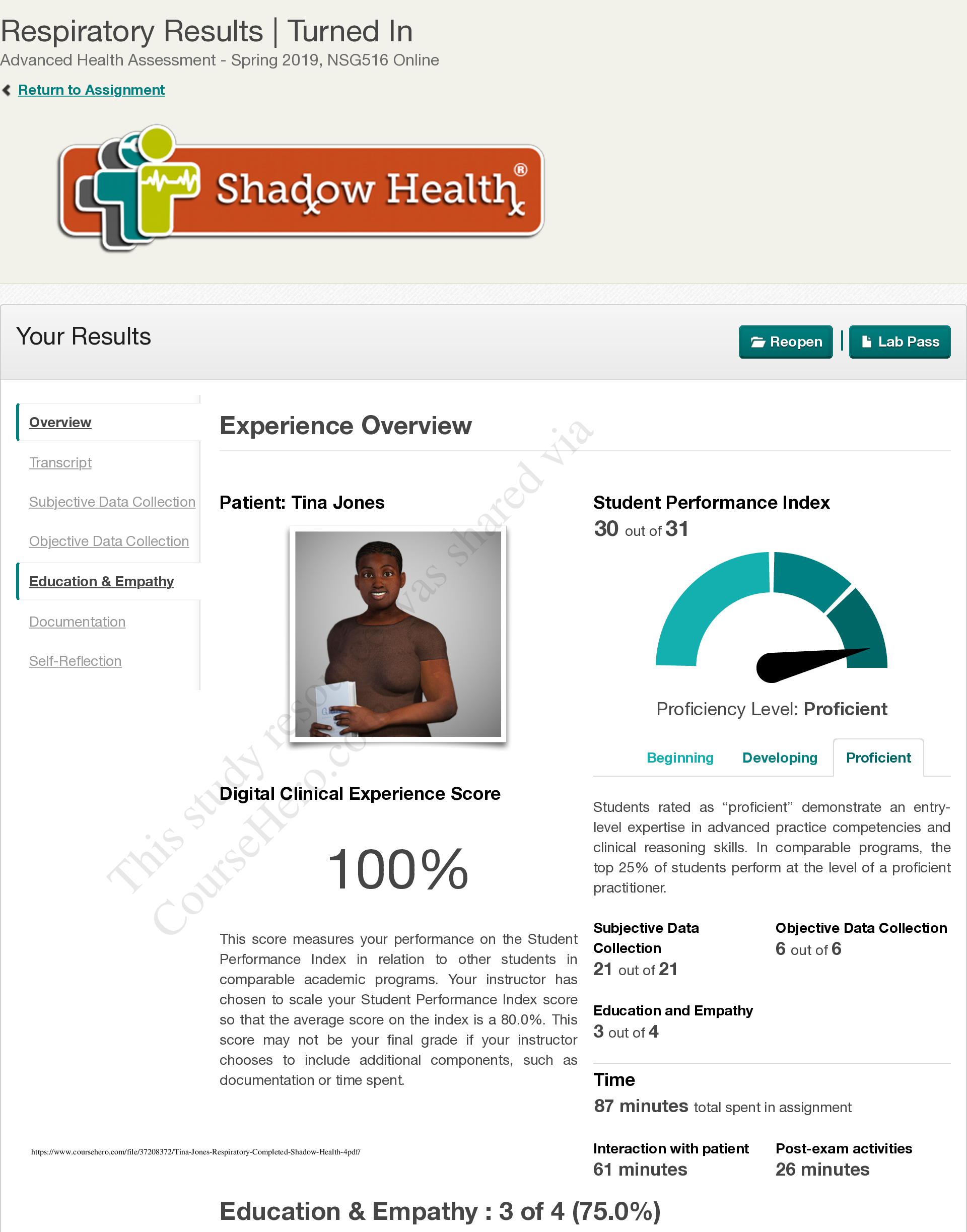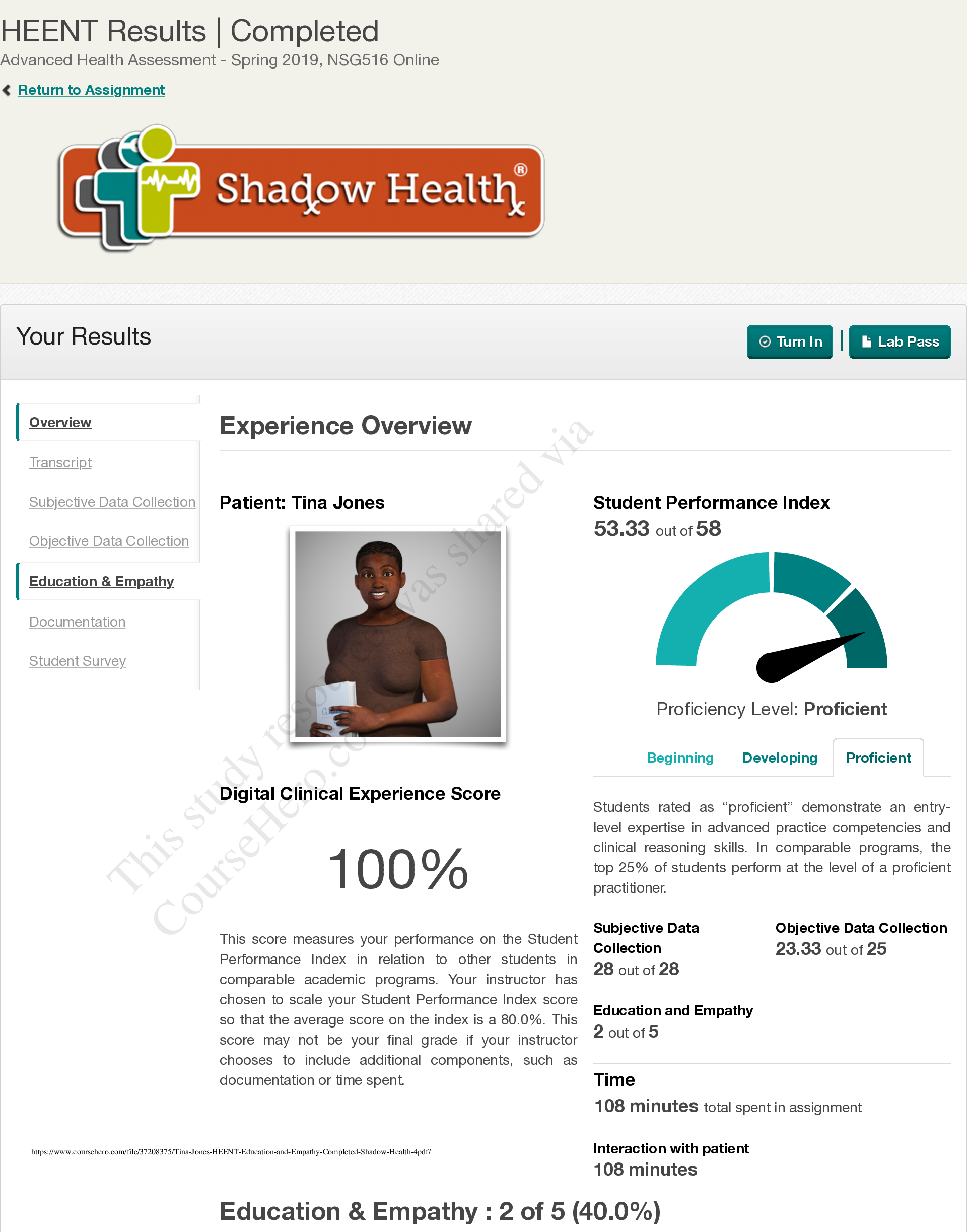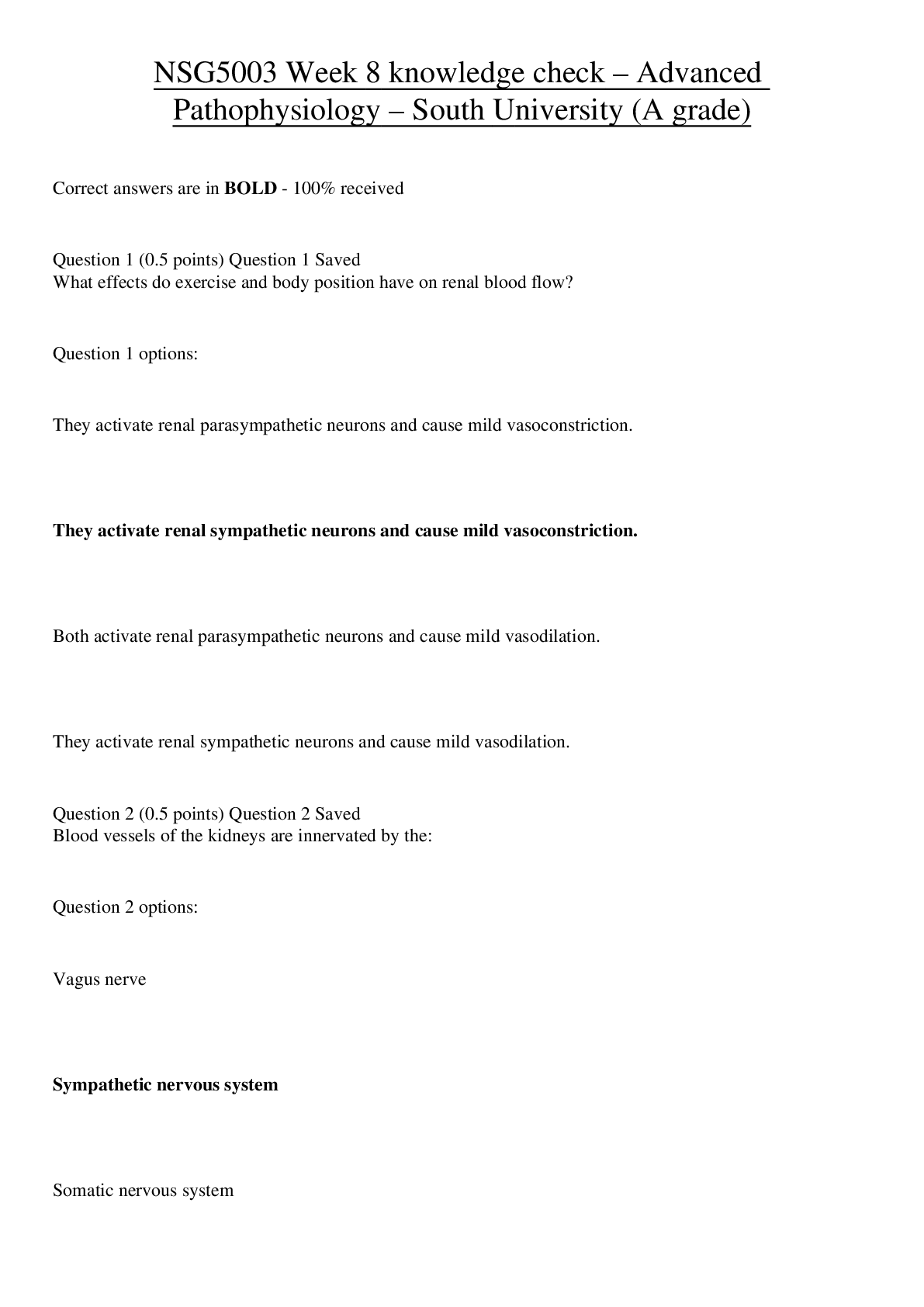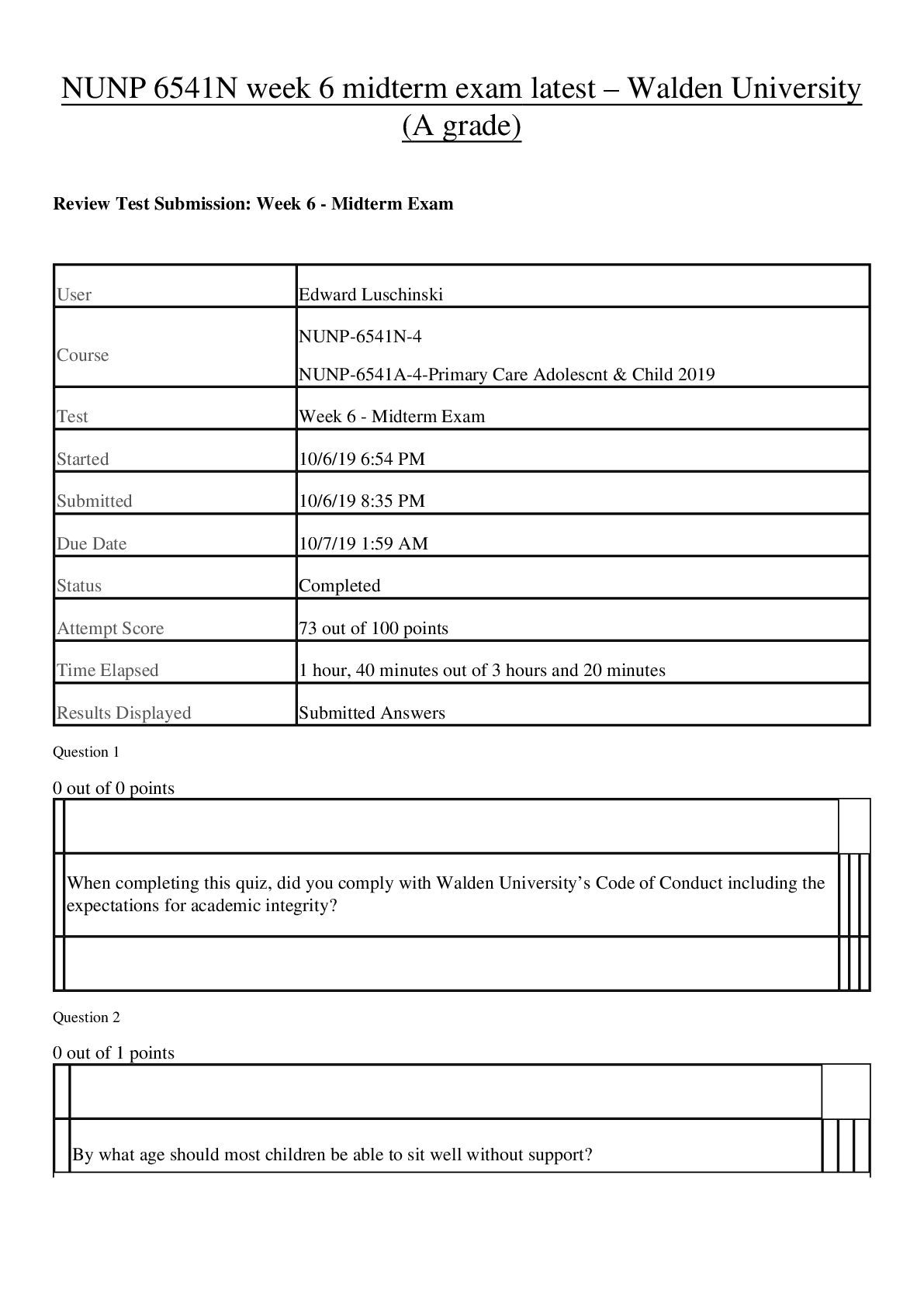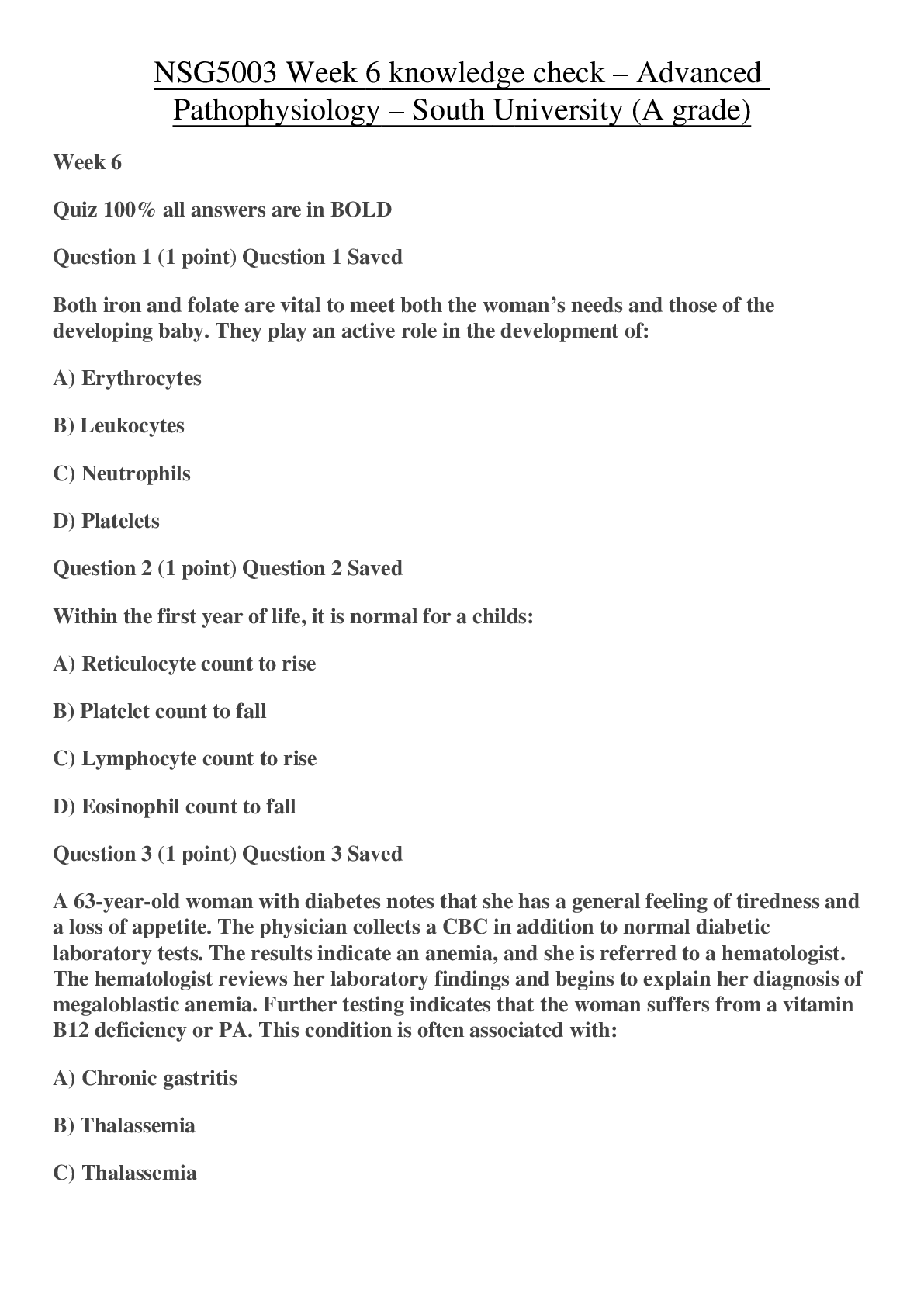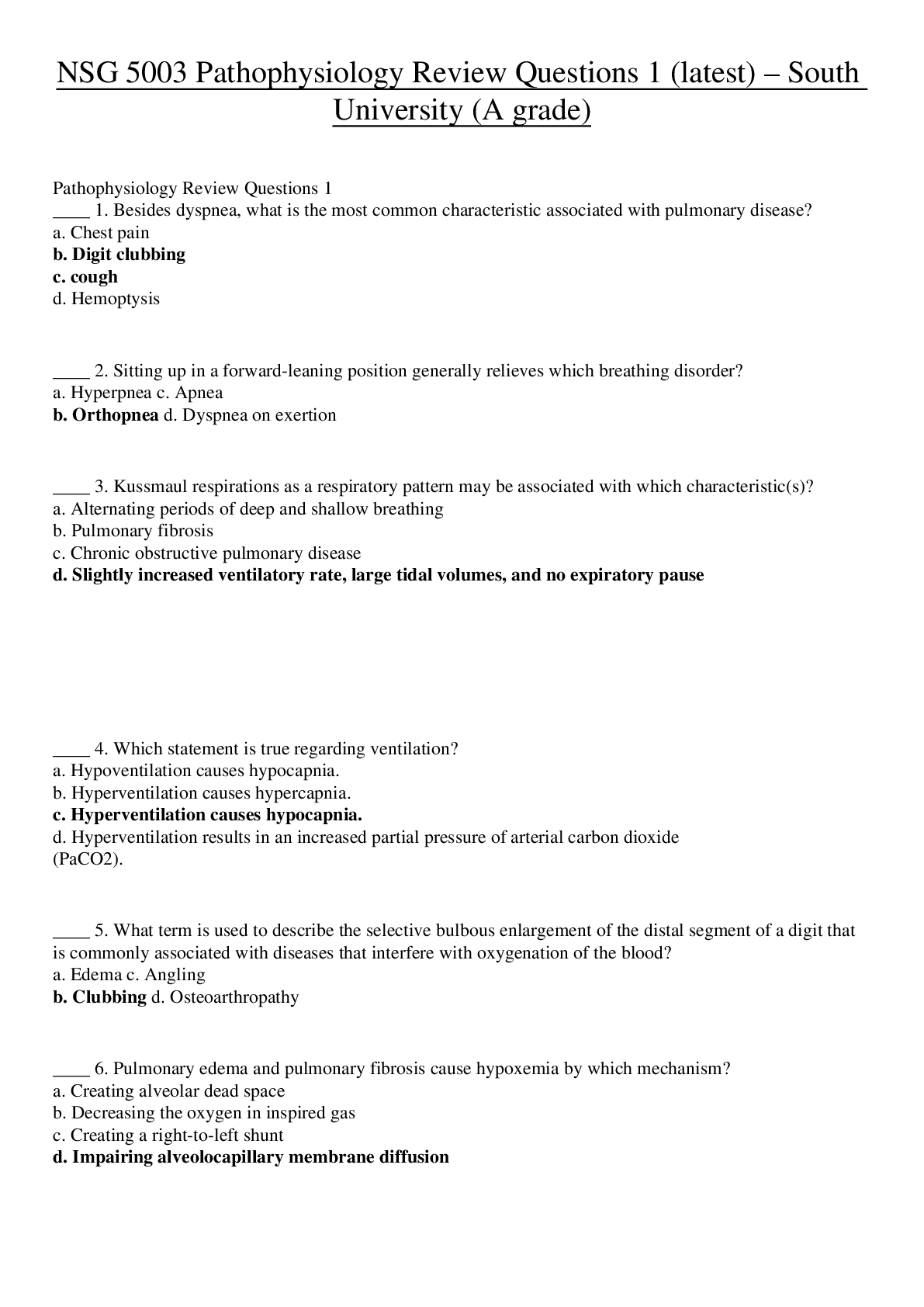*NURSING > EXAM > NSG 6420 week 4 cardiac (Fall 2020) with answers – South University (A grade) (All)
NSG 6420 week 4 cardiac (Fall 2020) with answers – South University (A grade)
Document Content and Description Below
NSG 6420 week 4 cardiac (Fall 2020) with answers – South University (A grade) 1. Hemodynamic, palpitations, fatigue, coagulation problems are potential effects of what diagnosis - Afib 2. Pati... ent has a bmi of 31 and dx of hx what should her calorie count be per day - 1800 with 30 minutes of exercise x 5 days 3. Pt has htn and db and has influenza what is she at risk for due to this - Pneumonia 4. Pt having symptoms of CHF what is the primary goal - Treat the symptoms (other answers were treat underlying cause, consider transplant, and education of disease and life expectancy/ quality of life) 5. Pt having varying degrees of chest pain both at rest and exertion that is increasing what is the likely working diagnosis - I picked unstable (but it could be MI) I couldn’t decide, other option was stable angina and 1 other one that didn’t make sense 6. What education should you give to someone newly diagnosed with hypertension - It was the longest answer about DASH DIET, lisinopril, continue hctz, weight reduction 7. Which one of these is not a known risk factor for CAD - I picked TOTAL CHOLESTEROL LESS THAN 150 (other options were smoking, obesity I think, htn) 8. Before deciding plan of care for potential pt with htn what should you do - Take 2 blood pressure 5 minutes apart 9. Pt calls and has been having mild to moderate chest discomfort with known history of CAD AND HTN. When should you consider hospitalization in someone with chest pain - I picked if they are in distress (A) Where is the point of maximal impulse (PMI) normally located? In the left 5th intercostal space, 7 to 9 cm lateral to the sternum 2. Which of the following correlates with a sustained, high-amplitude point of maximal impulse (PMI)? Hyperthyroidism Anemia Fever Hypertension 3. A 68-year-old woman with hypertension and diabetes is seen by the nurse practitioner for a dry cough that worsens at night when she lies in bed. She has shortness of breath, which worsens when she exerts herself. The patient’s pulse rate is 90/min and regular. The patient has gained 6 lbs over the past two months. She is on a nitroglycerine patch and furosemide daily. The explanation for her symptoms is: Kidney failure Congestive heart failure Angiotensin-converting enzyme (ACE) inhibitor induced coughing Thyroid disease 4. During a routine physical exam of a 90 year old woman, a low-pitched diastolic murmur grade II/VI is auscultated. It is located on the fifth intercostal space on the left side of the midclavicular line. Which is the following is the correct diagnosis? 5. You are performing a cardiac examination on a patient with shortness of breath and palpitations. You have the patient turn onto his left side in the left lateral decubitus position to listen to the heart. Which of the following Most common valvular disease in older adults is - Aortic stenosis During auscultation of the chest, your exam reveals a loud grating sound at the lower anterolateral lung fields, at full inspiration and early expiration. This finding is consistent with - Pneumonia & pleuritis - Week 4 Quiz 80% - Question 1 (2 points) - - A patient comes to a clinic for an annual visit. He has a history of Type 2 DM. His lab work today indicates creatinine of 1.6 (0.6–1.5). Last year, his BP was 138/80 in both arms. Today, his BP is 150/80 in both arms. - Which of the following is the most appropriate intervention? - Question 1 options: Placing him on an alpha blocker Counseling him to lower his BP with lifestyle modification Counseling him regarding lifestyle modifications and placing him on an ACE-I Counseling him regarding lifestyle modifications and placing him on a vasodilator - Question 2 (2 points) - - A seventy-eight-year-old African American woman presents to your office as a new patient. She complains of headache and dizziness. Her PMH is significant for HTN. She states, "I have been taking HCTZ for a long time." Her temperature is normal. BP 190/100, HR 86, RR 16. - Which of the following would be the most appropriate action to assist in determining how to treat her current symptoms? - Question 2 options: Perform a fundoscopic exam of her eyes. Perform a monofilament test on her feet. Order an echocardiogram for the next week. Order a lipid profile and liver panel. - Question 3 (2 points) - - A seventy-eight-year-old woman comes to see you for her annual visit. She has a history of osteoarthritis and GERD. She comes in today for her annual visit. Her BP is 148/88. Last year, her BP was 140/80 and you had advised a 2-gram sodium diet and exercise. She states that she has been faithfully following your instructions. - Which of the following would be the most appropriate management strategy for this patient? - Question 3 options: Praise her for her efforts and tell her to keep up the good work Start her on HCTZ 50 mg daily Start her on hydralazine 25 mg daily Advise her that she needs to follow a strict 1.5 gram sodium diet - Question 4 (2 points) - - A hypertensive middle-aged man has been recently diagnosed with mild renal insufficiency. He has been on lisinopril (Accupril) for many years. - Which of the following laboratory values should be carefully monitored? - Question 4 options: Hemoglobin, hematocrit, and MCV Serum creatinine and potassium levels AST and ALT Serum sodium, phosphate, and magnesium - Question 5 (2 points) - - Mr. Wilson is a seventy-three-year-old male who has been on rosuvastatin (Crestor) 20 mg QD for the past three months. He complains of diffuse muscle aches and severe fatigue and weakness in spite of getting his usual eight hours of sleep every night. - What is the MOST appropriate management for this patient? - Question 5 options: Stop Crestor. Half the dose of Crestor. Stop Crestor and send for liver panel. Switch to Lipitor 10 mg QD. - Question 6 (2 points) - - Your patients is a forty-five-year-old white male. You have been seeing him monthly for an elevated blood pressure. His reading three months ago was 160/100. He has been checking his blood pressure at home. The lowest reading he has recorded was 150/94. He tells you he has tried to change his diet and increase his exercise. You explain to him that you would like to start him on Lisinopril 10 mg po q hs today to try to decrease his blood pressure. As part of your teaching, you explain to him that he should notify you right away if after he starts the medication he notices ________. - Question 6 options: fatigue and depression swollen ankles and a headache a dry cough and angioedema thirst and dizziness - Question 7 (2 points) - - Mrs. Murphy presents to you for follow-up for the treatment of dyslipidemia. She is a fifty-five-year-old obese female with a BMI of 34%. She has no other cardiovascular risk factors. You have been working with her for several months on therapeutic lifestyle changes (TLCs). She has done well by increasing her exercise and reducing her BMI from 37 to 34. She does not smoke or consume alcohol. Her fasting lipid results today are: - Question 7 options: Total cholesterol 200, triglycerides 560, HDL 31, LDL 100 What would be the most appropriate treatment at this stage? Start cholesterol absorption inhibitor ezetamide (Zetia) and low-fat diet Start fibric acid (fenofibrate) and Omega 3 fatty acids and advise on restriction of simple carbohydrates Start moderate intensity HMG Co-A reductase inhibitor (lovastatin) and Aspirin Advise her to start bile acid sequestrate cholestyramine (Colestipol) and continue therapeutic lifestyle change - Question 8 (2 points) - - A sixty-year-old white male adult male client with essential hypertension diagnosed three months ago was initially treated by the nurse practitioner with sodium restriction, weight loss, and exercise. He presents with blood pressure of 160/100 on follow-up. He is asymptomatic and does not take any medication. EKG shows evidence of left ventricular hypertrophy (LVH). According to JNC-8, what would be the best choice of initial therapy? - Question 8 options: Consider “white coat” hypertension, continue lifestyle modification therapy, and reassess in three months. Start therapy with a beta blocker and refer for echocardiogram. Evaluate for cardiac risk factors and start therapy with an ACEI or an ARB. Measure 24-h free cortisol and refer for sleep study (polysomnography). - Question 9 (2 points) - - Saved - Choose the most compelling class of medications for the associated disease state. (Choose the best answer.) - Question 9 options: ACE-inhibitor (ACEI) or angiotensin receptor blocker (ARB) for chronic kidney disease Calcium channel blocker and diuretic for African American individuals Labetolol or hydralazine for pregnancy-induced hypertension A & B All of the above (A.B.C.) - Question 10 (2 points) - - Mr. Murphy is a forty-eight-year-old male who presents for evaluation of his elevated cholesterol. He is also treated for hypertension with chlorthalidone 25 mg once daily. He smokes ½ ppd. He denies prior cardiovascular disease or diabetes. His TC is 260, Trig 283, HDL 38, and LDL value is 192 mg/dL. His ten-year calculated ASCVD risk is 17.8%. According to the ACC/AHA guidelines, what is the most appropriate treatment at this stage? - Question 10 options: Institute therapeutic lifestyle changes (TLCs) and recheck the lipid panel in four to six months. Institute moderate-intensity statin treatment (i.e., Atorvastatin 20 mg or pravastatin 40 mg) plus therapeutic lifestyle changes (TLCs). Institute high-intensity statin treatment (i.e., Atorvastatin 40 mg or rosuvastatin 20 mg) plus TLCs. Start nicotinic acid (Niacin 1000 mg) and Omega 3 fatty acid. - [Show More]
Last updated: 1 year ago
Preview 1 out of 9 pages
Instant download
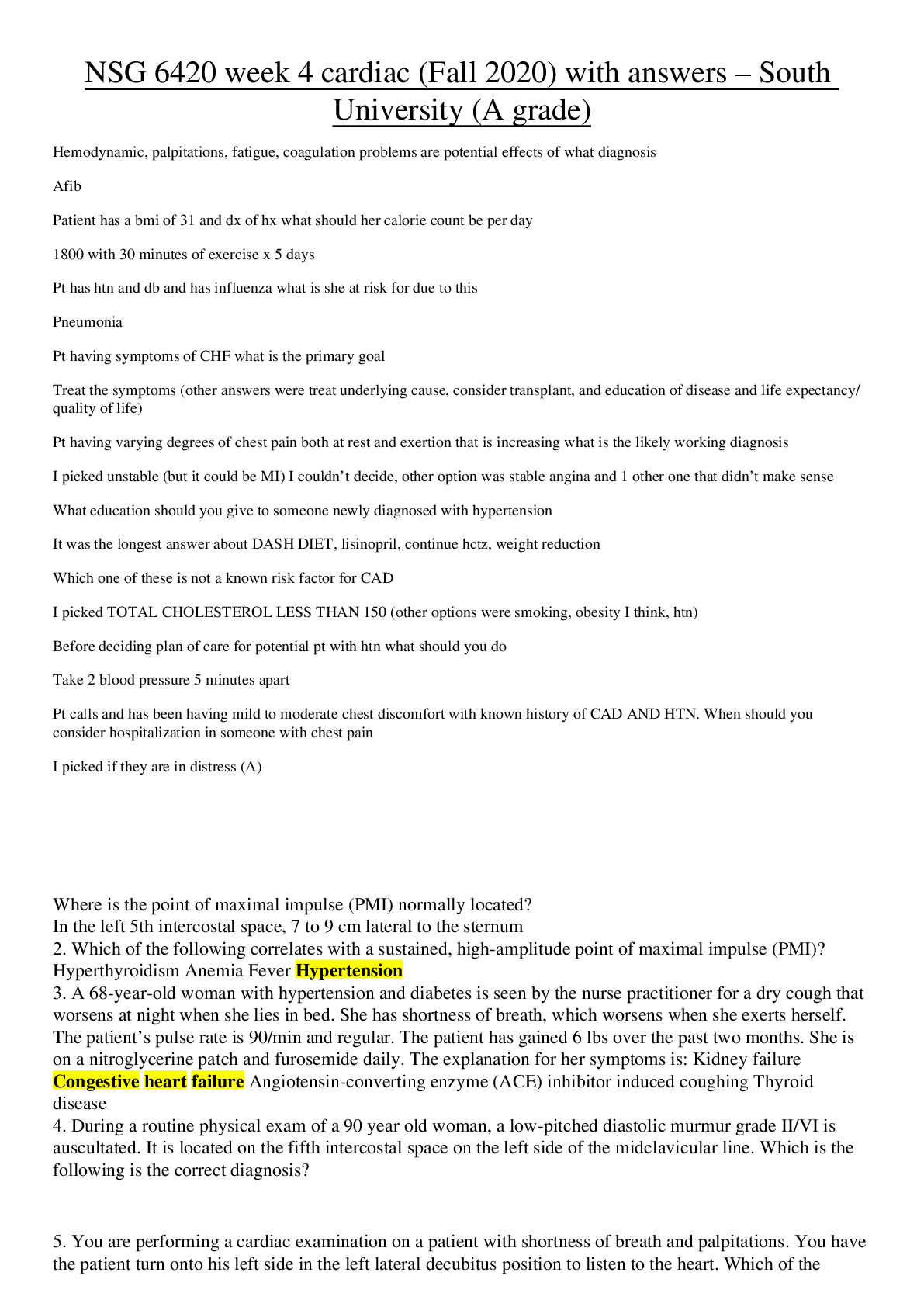
Instant download
Reviews( 0 )
Document information
Connected school, study & course
About the document
Uploaded On
May 14, 2020
Number of pages
9
Written in
Additional information
This document has been written for:
Uploaded
May 14, 2020
Downloads
0
Views
142














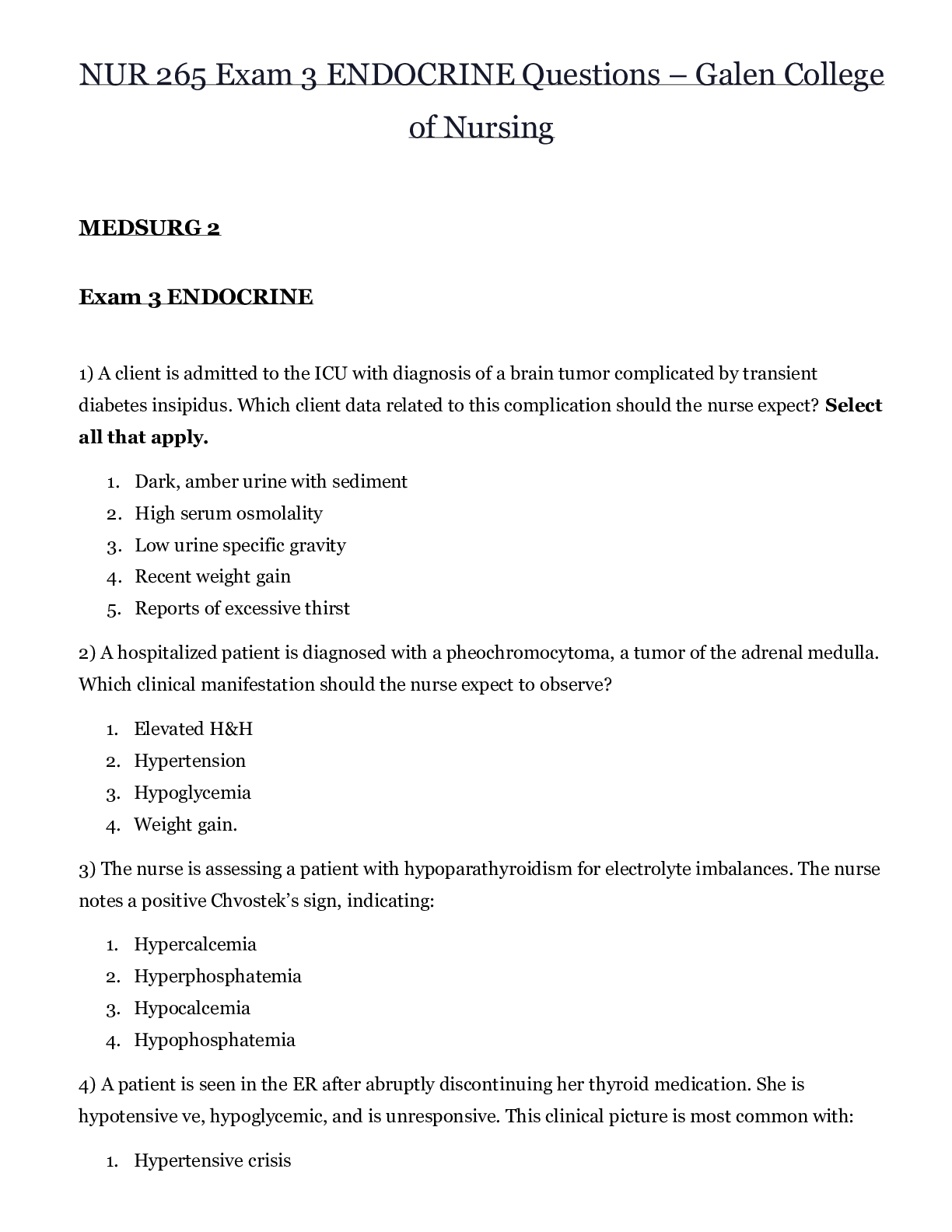
 – CHAMBERLAIN COLLEGE OF NURSING.png)
